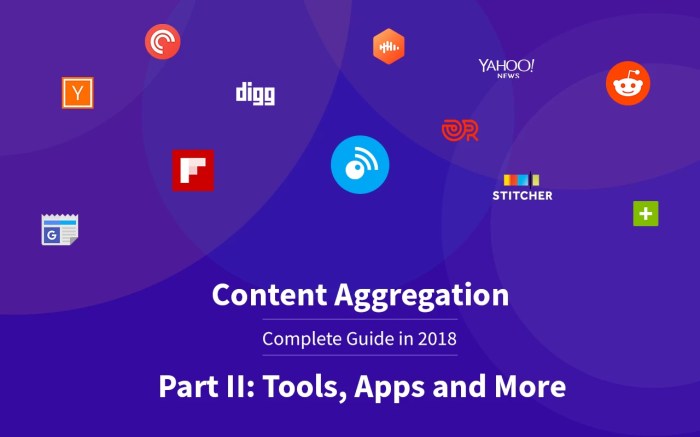Using Content Aggregation Tools sets the stage for a tech-savvy journey into the world of streamlined information consumption, where the power of data organization reigns supreme.
In this digital era, having the right tools to aggregate and manage content efficiently can make all the difference in how we consume and utilize information.
Introduction to Content Aggregation Tools
Content aggregation tools are platforms or software that gather information from various sources on the internet and display it in one centralized location for easy access. These tools help users stay updated on specific topics of interest without having to visit multiple websites individually.
Purpose of Content Aggregation Tools
Content aggregation tools aim to streamline the process of consuming information by presenting it in a consolidated format. Users can customize their feeds to include only relevant content, saving time and effort in searching for updates across different websites.
- Feedly: A popular tool that allows users to curate content from their favorite websites and blogs, organizing it into a personalized feed.
- Flipboard: Known for its visually appealing layout, Flipboard aggregates articles, videos, and social media posts based on user preferences.
- Pocket: This tool enables users to save articles, videos, and other online content to read or watch later, even offline.
- Google News: Utilizing algorithms to gather news from various sources, Google News provides a customizable news feed based on user interests.
Benefits of Using Content Aggregation Tools

Content aggregation tools offer a range of advantages that can significantly enhance efficiency and productivity in information consumption.
1. Centralized Information Access
- Content aggregation tools gather information from multiple sources and present it in one centralized location.
- Users can access a variety of content such as news updates, social media feeds, and blog posts without having to visit individual websites.
- This saves time and effort by eliminating the need to switch between different platforms.
2. Customizable Content Curation
- Users can personalize their content feeds based on specific interests and preferences.
- Content aggregation tools allow for the creation of custom feeds, ensuring that users receive relevant and targeted information.
- By curating content, users can focus on what matters most to them and avoid information overload.
3. Enhanced Collaboration and Sharing
- Content aggregation tools facilitate collaboration by enabling users to share curated content with team members or peers.
- Teams can stay updated on industry news, trends, and developments through shared content feeds.
- This promotes communication and knowledge sharing within organizations, leading to improved decision-making and productivity.
4. Streamlined Research and Monitoring
- Researchers and analysts can use content aggregation tools to monitor competitors, industry trends, and market developments.
- These tools automate the process of gathering and organizing relevant information, saving valuable time and effort.
- By streamlining research and monitoring activities, users can stay informed and make data-driven decisions more efficiently.
Features to Look for in Content Aggregation Tools

When selecting a content aggregation tool, it’s essential to consider key features that can enhance your content curation process and improve overall efficiency. These features can vary from tool to tool, so it’s important to evaluate them based on your specific needs and goals.
Customization Options
Customization options play a crucial role in content aggregation tools as they allow users to tailor the tool to their preferences and requirements. Look for tools that offer flexibility in organizing and displaying content, such as the ability to create custom feeds, filter content based on specific criteria, and customize the layout and design of the aggregated content.
Integration Capabilities
Another important feature to consider is the integration capabilities of the content aggregation tool. The ability to integrate with other platforms, such as social media, email marketing tools, and CMS systems, can streamline your content distribution process and improve overall workflow efficiency.
Automation and Scheduling
Efficiency is key when it comes to content aggregation, so look for tools that offer automation and scheduling features. These features can help you automatically gather and publish content at specified times, saving you time and effort in the long run.
Analytics and Reporting
To track the performance of your aggregated content, it’s important to choose a tool that provides analytics and reporting capabilities. Look for tools that offer insights into content engagement, audience behavior, and other relevant metrics to help you optimize your content strategy.
Collaboration Features
If you work in a team environment, collaboration features are essential in a content aggregation tool. Look for tools that allow for easy sharing, commenting, and collaborative editing to facilitate teamwork and communication within your content curation process.
Mobile Compatibility, Using Content Aggregation Tools
In today’s mobile-centric world, it’s crucial to choose a content aggregation tool that is mobile-friendly. Ensure that the tool you select is compatible with various devices and platforms, allowing you to access and manage your aggregated content on the go.
Best Practices for Effective Utilization of Content Aggregation Tools: Using Content Aggregation Tools
When it comes to making the most out of content aggregation tools, there are several best practices to keep in mind. These practices can help you organize your content efficiently and overcome any challenges that may arise along the way.
Consistent Tagging and Categorization
- Ensure that you use consistent tagging and categorization methods to classify your content accurately.
- By maintaining a standardized approach to tagging, you can easily filter and search for specific content when needed.
- Take the time to create a comprehensive tagging system that aligns with your content strategy and goals.
Regular Content Updates
- Make it a habit to regularly update and refresh your aggregated content to keep it relevant and engaging.
- Set a schedule for reviewing and updating content to ensure that outdated information is replaced with current data.
- By staying on top of content updates, you can maintain the quality and accuracy of your aggregated content.
Collaboration and Communication
- Encourage collaboration among team members by using content aggregation tools that support shared access and editing capabilities.
- Establish clear communication channels for discussing content updates, revisions, and feedback within your team.
- By fostering a collaborative environment, you can streamline content management processes and improve overall efficiency.
